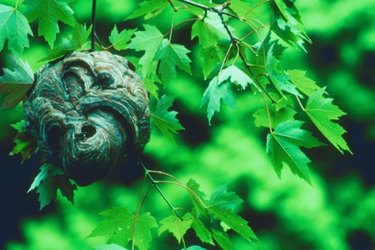
There are approximately 15,000 different species of wasps, and the black hornet (folichovespula maculata), also called the bald-face hornet, is a member of this family. It is an "eusocial" insect, which means it has a cast system, with a hornet queen at the helm. The black hornet feeds off flower nectar, sap and other smaller insects. However, unlike other wasps, it does not use its stinger to paralyze its prey. It uses it only when provoked.
Characteristics
Video of the Day
The black hornet is distinguishable by its all-black body, which measures up to 3/4 inch long. A thick-body insect, the hornet usually has small white markings on the face, the thorax and the tip of its abdomen. Its body is hairless and slick, and the insect holds its cloudy gray wings parallel to the side of its body. There are four types of black hornets that can be in the nest at any given time: the queen, the female sterile workers, the male sterile drones and the new female queen. All of them look relatively the same, except the male drones lack stingers.
Video of the Day
Nest
The black hornet is known for its football-shaped nest that is attached to branches or inside shrubbery. The nest's paper-like construction is a product of chewed strips of wood and saliva. It starts out as a couple of cells created by the queen, and grows to accommodate the hornet community as it flourishes. As the nest gets bigger, it is reinforced with twigs and branches by the worker hornets. In warmer climates, their nest can keep growing, reaching up to three feet long. However, typically, one nest averages around 12 to 20 inches long and can hold up to 700 hornets -- its opening is situated at the bottom.
Life Cycle
Every spring, the queen bee comes out of hibernation and starts off the colony. It lays around seven eggs, and brings back food (masticated insects) to feed the larvae. Each offspring spins silk-like cocoons inside its cells and pupates into an adult hornet. The first round of eggs the queen lays are sterile female workers that continue to forage and build the nest. The rest of the eggs that the queen lays will produce male hornets. The sterile females become fertile by the end of the summer and are impregnated by the male hornets. These fertile females then go underground to hibernate and the male insects die off. The nest is abandoned and left to wither away for the winter.
Climate
Black hornets are indigenous to the United States, as they tend to reside in climates that have four seasons. Though there are communities all over the United States, they are often found in places like the Rocky Mountains and California, where they are typically found in meadows, on the edges of forests, or in parks. Outside of the United States, the black hornet can be found in the southern parts of Canada.